
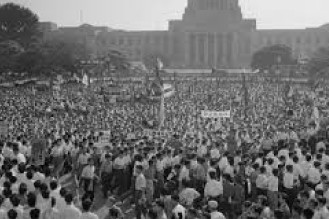
With Japan rife with anti-government protests on an unprecedented scale protesting the U.S.‐Japan Security Treaty, the Ikeda Cabinet announced the “Income Doubling Plan” in 1960. This plan called for sustained economic growth of around 9% and the GNP and national income to double over a 10 year period. This resulted in Japanese economic growth exceeding even these lofty expectations, with average growth of 10.9% leading Japan on the path to becoming an economic superpower. Maruyama Transport was founded in 1962, right amidst this incredible economic upswing. In the two years after the Company’s founding, the whole of Japan came together as one to celebrate the Tokyo Olympics, ushering in an age of rapid development.

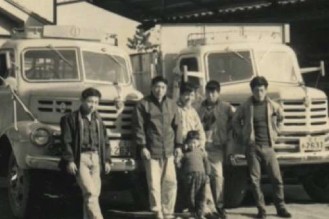
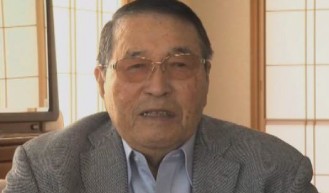
In 1962, Kyushu Can Co., Ltd. (now the Daiwa Can Company), an affiliate of Yawata Iron & Steel Co., Ltd. (now the Nippon Steel Corporation) acquired a special license as a cargo shipper and, with this, Maruyama Transport was started with just a single truck. Japan was then enjoying a period of economic prosperity. Riding the waves of this economic boom, we continued to gradually increase our line of trucks and employee base as sales steadily grew. However, as we were operating on the basis of a special license, we could not transport cargo from other customers. Kyushu Can Co., Ltd. remained our one customer. In 1965, our sole client, Kyushu Can Co., Ltd, was absorbed into the Daiwa Can Company, which had continued to grow its business following the construction of its Shimizu and Osaka Plants. At the same time, large numbers of business partners were reevaluated and replaced. It goes without saying that Maruyama Transport was one such partner. After a solid start in which the Company thought it had found a stable foundation for its business, it was now standing at a major crossroads in this, just the third year since the Company’s founding. Amidst these trying circumstances, the Company was greatly spurred on by the steadfast approach to work taken up by our founder, Takeo Miura, in which the “Freight owner as king. We will take on whatever work is given to us. Where other companies will only travel once per day, we will travel two or three times over.” The Company earnestly approached whatever unreasonable demand was thrown at it from those involved in transporting goods, presenting a solution and overcoming difficulties alongside its clients. The acclaim received for this approach to our work was passed on from Kyushu Can to the Daiwa Can Company, and before we knew it, the new Company was back on the path to stability.

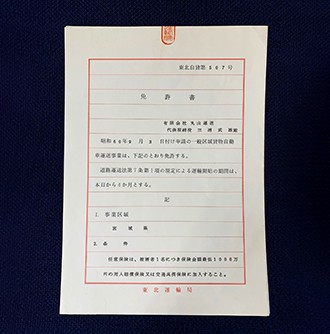
In 1981, the founder’s eldest son, Kazuo Miura, took over the reigns of the Company. However, in this, now close to the 20th year since the Company’s founding, Maruyama Transport still only had eight vehicles and eight employees to its name. It had continued a relaxed approach to management that focused solely on work received from the Daiwa Can Company. At the time the sales performance of the Daiwa Can Company had also began to slide. While a stable amount of work was coming in, sales representatives from various other competing companies continued to frequently knock on Daiwa Can’s door with various proposals. At the same time Maruyama Transport was faced with a dilemma—while the Company did have a flurry of work offers from new customers who had heard of Maruyama Transport’s reputation, the Company was unable to capitalize on these opportunities due to the special license granted to the Company prohibiting work from sources other than the Daiwa Can Company. Amidst these circumstances, President Miura was not only wary of the risks posed to the Company’s business by relying solely on a single company for sales, he also had an earnest desire to take on the challenge that new work offers would bring. For these reasons, Maruyama Transport acquired a general freight transport license in 1985, which would allow it to take on work from various other freight owners, and began an aggressive sales campaign targeting major companies in the local area. Of course, the only employee that could call himself a salesman at the time was Mr. Miura himself.

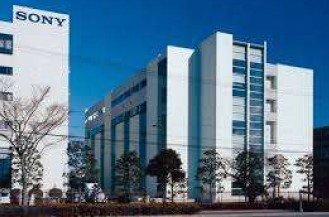
With the acquisition of a general freight transport license in 1985, Mr. Miura embarked on an aggressive sales campaign targeting major companies in the local area. The Company’s primary target, even if it meant pulling its focus from other areas, was Sony—a company that was making aggressive inroads in the market in its aim to becoming a trillion yen company, with the Walkman, the 8 mm video camera, and other revolutionary new products turning heads the world over. At the time Sony needed to bolster its logistics capabilities in order to cope with the expected boost in product shipments accompanying its global strategy. However, the products to be transported by truck contained precision components susceptible to vibration and moisture. For a company that had, at the time, still only had experience handling canned goods, we were taken aback by the strict demands that Sony called for. It took three years to meet each of these demands before we could finally enter into a freight contract with Sony in 1988. Since then, we have seen tremendous growth on the back of the hit Sony products we have delivered to the world, including the Walkman, the 8 mm video camera, video tapes (VHS, BETA and 8 mm tapes), CD, MD and other recording media, and the PlayStation line of video game consoles. The some 65 million Suica cards that have been issued over the years were also produced by Sony, which Maruyama Transport delivered to the East Japan Railway Company (Shinagawa). Before we knew it, Maruyama Transport—the last of the five transportation companies that had entered into a freight contract with Sony—had now become the top distributor of Sony products. This was only achieved as a result of all drivers and Maruyama Transport employees dedicating themselves to their work with a great sense of pride and satisfaction derived from delivering Sony’s products to the world. With the increase in workload, the Company’s sales, and the number of Company trucks and employees grew rapidly. Unfortunately, in getting to this point we began to face the same issue we dealt with in the past. Before we knew it, Sony accounted for close to 70% of our sales and, as in the past when the Company was operating on a special license, the Company’s bottom line was heavily reliant on sales from a single company. This concern was shared by the General Manager at Sony at the time, someone who we were greatly indebted to. His kind words spurred us on, stating that “the fact that you are in charge of Sony’s distribution is a mark of an outstanding transportation company. You should present this as a sales point to bring in further work offers from other companies to better balance out your sources for revenue.” This advice from the General Manager was put into practice, with work requests from new clients coming in rapid succession, including from well-renowned companies such as Toyo Suisan Kaisha, Tokyo Electron, AGC, IRIS OHYAMA and FUJIFILM. Much of what we know about logistics was garnered from our work with Sony, and many of our new clients are captured based on the trust we have earned as the main transporter of Sony’s products. It is not a stretch to say that Maruyama Transport grew into the company it is today thanks to the marvelous presence Sony has been.

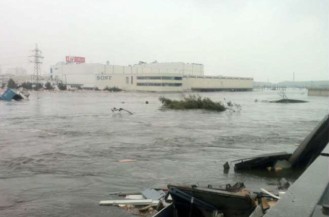
and recovery efforts
On March 1, 2011, with the Company’s 50th anniversary set to take place the following year, Maruyama Transport had grown to a company with 180 employees and annual sales in the order to 2 billion yen. Many of our business partners had gathered in a hotel in central Sendai for a customary briefing on the Company’s business outlook for the future. At the event, President Miura proudly announced the Company’s basic policy and growth strategy heading into its 50th year. Just when all employees had gathered as one to make one final push towards the 50th anniversary, the events of March 11 took place. At 2:46 in the afternoon on that day the Tohoku region was hit by a massive earthquake. Located around 500 meters from the wharf at Sendai Port, Maruyama Transport immediately evacuated its employees to a nearby shopping center upon receiving the tsunami warning issued by the Meteorological Agency, with President Miura and several other employees retreating to the top floors of the multistory employee parking garage adjacent to the head office. An MCA radio was the only thing we could take with us from the office. The multistory car park rises to four stories above ground. The robust steel-frame structure did not flinch in the face of the oncoming earthquake shocks. But the car park had no walls or roof, making it completely exposed. Immediately after using the radio from the top floor of the car park to call all Company vehicles away from the shoreline, a massive wall of dark sea water came surging closer. At this time the employees that had evacuated to the car park steeled themselves in the face of what looked to be certain death. The tsunami waves that came crashing in were of a scale that greatly exceeded our expectations. Trailers getting pulled along with a thunderous roar, cargo ships floating on places which should be dry land, utility poles bending on the impact from containers, people who failed to escape in time getting sucked into the waves—all we could do was look on as nature’s fury played out before us in what seemed to be the work of the devil. Before we knew it the water line had reached our feet standing on the fourth floor of the car park before thankfully stopping before ascending any further. The temperature at the time was below freezing. We were forced to spend the night in freezing conditions, unable to move.
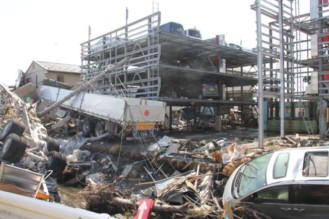
As the eastern sky started to light up at around 5 o’clock on the following morning, all employees were left speechless at the hellish scenes before us. The state of damage was just as it was reported on news programs and in the newspapers. We still could not believe that we had managed to survive such a terrible site, and that our company remained standing. What about our families? Our homes? The company? Other employees? Our trucks? What should we do now? Overcome with these continuous doubts and anxiety, we waited for the sea water at our feet to subside. As a result of this disaster, our company office, warehouse and maintenance facility were completely destroyed. 58 operating vehicles (trucks), 47 employee-owned vehicles and two forklifts were swept away in the tsunami. We lost the majority of our head office facilities, and all employees found themselves in a position where the continuity of the business itself was threatened. Amidst these circumstances, the fact that we were able to verify the safety of all employees on the second day following the disaster was a silver lining among the dark clouds of despair. This disaster reduced our head office and the surrounding area to a pile of rubble. The fact that we were able to verify the safety of all 180 employees with such amazing speed—just two days from the occurrence of the disaster—with all communications infrastructure completely destroyed rendering it impossible to communicate by not only land line phones, but by mobile phones as well, is largely thanks to the quick thinking to take the MCA radio with us before the tsunami came in. This worked as our only means of communication, establishing a communications network with sites outside the disaster zone. This experience spurred us on to take a new step toward the future.
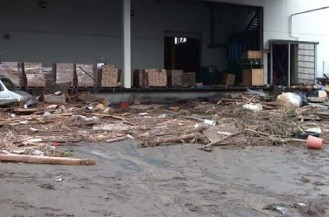
On the third day following the disaster, full-fledged searches for missing persons finally began to get underway in the afflicted areas. That day, the employees that were able to come to work gathered in front of our head office covered in sludge and debris and carried out a morning assembly. Standing before the employees outwardly showing concern for their future, in a booming voice President Miura declared his determination that the Company was to “press forward and adhere to the management policy announced in the lead up to the 50th anniversary.” Upon hearing this the employees were left in shock. The Company had lost its head office, warehouse, trucks—everything needed to perform its work. Not only that, we had no idea where the packages consigned to us ended up. Continuing business operations seemed unthinkable to all present. These inconceivable words thrown out by President Miura under these trying circumstances struck a chord among the employees and brought them to tears. This was the moment where Maruyama Transport took its first step toward recovery. With his own house under water, and his car missing, President Miura left his personal problems up to his family, riding to work on a bicycle as he worked feverishly to restore the Company. With there being no end in sight for electricity, communications, gas, water and road recovery efforts, we meticulously worked to restore the functions of the head office, establish an understanding of the damage conditions and report this to clients and business partners, brief financial institutions and restore the lives of affected employees, in addition to numerous other recovery efforts that had piled up, much like the debris outside. As a result of these efforts, we were able to restart business operations on the 11th day following the disaster. Thankfully, our business locations outside the disaster zone were capable of taking over work from the head office, preventing the loss of clients. However, with the head office and Iwanuma warehouse completely destroyed, all we could do was offer our sincerest apologies for the loss of cargo stored in the wake of the tsunami. In response, employees from the President down that were available split up to visit each client and give a considered explanation of the situation we were faced with. Most clients responded with heartwarming words of sympathy. One employee received a particularly moving message of encouragement hoping for our recovery, stating “Don’t worry about the packages, just make sure you get your house in order. We will be waiting for that day.” This was reported back to all employees, further strengthening our resolve toward recovery. About one month after the earthquake all employees were able to come to work. With this, the locomotive setting out to achieve the objectives of our management plan finally pulled out of the station. This train linked tightly with the collective strength of all employees began to gradually gather speed, leaving the scenes of this disaster behind us. The expression on the faces of those employees going about their work was no longer that of a disaster victim, but one positioned to aid in the recovery efforts through cargo distribution, tirelessly working to deliver cargo for clients both old and new, and to support the recovery effort. As a result of these efforts sales grew 10% over the previous year in FY2011. While many companies affected by the disaster attempted to tide over the crisis by reducing the scale of their business activities and cutting staff, Maruyama Transport both expanded the business and took on new employees during this period. In other words, this 10% year-on-year growth was the direct result of the 180 employees answering the call from President Miura to “hold fast to the Company’s management policy” announced at that morning assembly held amidst the rubble on the third day following the earthquake. That year, the President Miura-led Maruyama Transport became a miracle train on the road to recovery.
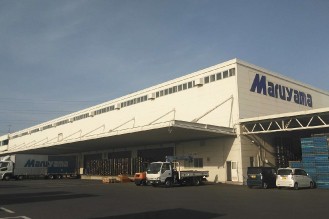
The Great East Japan Earthquake brought unprecedented damage to the Tohoku shoreline. With the loss of all of the functions of the head office due to the tsunami, all employees stood together to miraculously put the Company back on the path to recovery. That is not to say that the employees were not skeptical at our ability to relocate our head office—the most pressing objective incorporated into the management plan. While there was some calls of concern that it was too early to make such a move, spurred on by the unwavering resolve to “adhere to the management plan,” and by the courage shown by our employees as we went about our recovery efforts, President Miura pressed on to establish a new head office on a site area some 20,000 m2, with a warehouse 10,000 m2 in size. Three months had passed since the earthquake. Piles of debris were heaped high around the Company building. The scars from the earthquake still remained fresh. President Miura had no idea how he was going to raise hundreds of millions of yen in funding for a simple capital investment initiative, rather than as part of the reconstruction efforts of a devastated company. Government estimates had pegged the amount of damage directly caused by the disaster at 16 - 25 trillion yen, causing a state of chaos at financial institutions. Applying for a loan under such circumstances was proving extremely difficult, with President Miura basically being turned away at the door at most banks. However, the desire of President Miura to provide employees with a better working environment, along with the sense of trust built up over the close to 50 years since the Company’s founding, together with tenacious negotiation efforts finally swayed financial institutions. As a result, we received an extremely large loan for capital investment, in addition to loans for capital increases from the Development Bank of Japan. From here, we established the head office relocation project with the aid of employees, while pursuing land and building contracts. On December 23, 2011—the very same year as the earthquake, all employees went through another shift in the Company’s trajectory—the commencement of business activities at the new office.

Our experiences with the earthquake trained us in crisis management, the power of presenting a united front, an unwavering spirit, as well as other valuable lessons. What employees found particularly moving were the heartwarming messages of support sent from our clients, and the hopes for our recovery. This reaffirmed in us that the energy driving our business was not gasoline or electricity, but the “hearts and minds of the people.” The feelings of our employees, the feelings for one’s family, the feelings of our customers, the feelings of our business partners. Now, five years on from the earthquake, we hoped to establish a Company branding themed on the “heart and mind.” The first numbers we recognize as children are the first ten natural numbers, 1, 2, 3, 4, 5, 6, 7, 8, 9 and 0. These ten numbers can be manipulated and combined to express a whole manner of different things, from math, to health, the economy, global trends and events in space. Of these ten numbers, only “8” and “0” are continuous and symmetrical. We see these numbers as symbolizing “permanence” and “harmony.” Surrounding the symbol for permanence, “8.” at the center, is harmony with our business partners and local communities on the right, and harmony within the Company itself on the left. Incorporated within the “the 080” brand is the hopes of Maruyama Transport for the harmony and lasting prosperity of all companies and people we encounter, and for wider society itself.

























